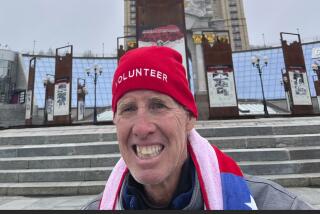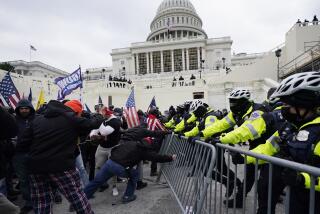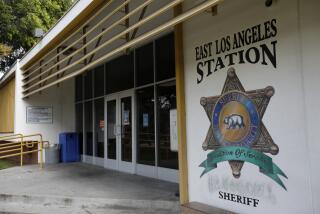FBI Agent Memo Urged Probe of Suspect Tied to 9/11
WASHINGTON — A memo from a Phoenix FBI agent urging the bureau to investigate Middle Eastern men at American flight schools focused on a suspect who had repeated contacts with one of the Sept. 11 hijackers--a disclosure lawmakers said signaled yet another missed opportunity to unravel the plot months before the terrorist attacks.
The suspect--whom authorities declined to identify--may have trained and screened pilots involved in the plot, according to testimony at a congressional hearing Tuesday. The new information contradicts repeated statements by law enforcement and intelligence officials over the last year that none of the suspects identified in the so-called Phoenix memo was linked to Sept. 11.
The FBI has since learned that the suspect in the memo met repeatedly with Hani Hanjour, who is believed to have seized control of the American Airlines plane that crashed into the Pentagon.
In other testimony, a Minneapolis FBI agent said he warned officials in Washington that Zacarias Moussaoui, accused of being the intended 20th hijacker, might be part of a plot to “take control of a plane and fly it into the World Trade Center.”
The flurry of disclosures indicate the Sept. 11 plot was not as compartmentalized as U.S. intelligence officials have claimed. Indeed, the thrust of Tuesday’s testimony underscored that a web of connections between the hijackers and others who had come into investigators’ sights is still emerging.
Tuesday’s hearing focused on lapses in the FBI’s handling of the Phoenix memo and the investigation of Moussaoui, who is awaiting criminal trial in federal court in Virginia.
In both cases, FBI officials in Washington failed to heed prescient warnings from field offices.
Eleanor Hill, director of the congressional investigation, on Tuesday attributed the FBI’s lapses to a “myopic” culture in the bureau before the Sept. 11 attacks that prevented officials from recognizing broader patterns and threats.
In fact, FBI officials now theorize that the suspect, who had significant flying experience, helped to train Hanjour and may have been screening other would-be Al Qaeda hijackers to determine whether they were capable of carrying out the Sept. 11 attacks.
“That is an investigative theory” the FBI is pursuing, said Kenneth Williams, the author of the July 10, 2001, memo urging officials in Washington to launch a probe of flight schools across the country.
Hill said the FBI had been alerted to the possibility of terrorists training in U.S. flight schools well before the Phoenix memo.
In 1998, she said, an FBI pilot in Oklahoma City wrote a memo expressing concern about the number of Middle Eastern flight students he had encountered in schools there, and speculating that they could be planning attacks.
But even given these previous warnings, and the avalanche of intelligence traffic warning of imminent Al Qaeda attacks during the summer of 2001, the FBI essentially dismissed the Phoenix memo.
New York FBI agents who reviewed it found it “speculative and not particularly significant,” Hill said. Indeed, the agents said they knew associates of Osama bin Laden trained at U.S. flight schools, but thought the students posed no direct threat.
“The commonly held view at the FBI prior to Sept. 11 was that Bin Laden needed pilots to operate aircraft he purchased in the United States to move men and materiel,” Hill said.
In the wake of the attacks, FBI Director Robert S. Mueller III and others have downplayed the significance of the Phoenix memo, saying there were no links between suspects named in the memo and the Sept. 11 plot.
But the FBI has since uncovered an alarming connection between one of the individuals named in the memo and Hanjour, a Saudi citizen who first came to the United States in 1991. The memo names 10 individuals, none of whom have been identified publicly.
The connections between the suspect and Hanjour date back to 1997, Hill said, when they began training together at an Arizona flight school. At least one instructor at the school said the two men may even have carpooled together.
Records obtained by the FBI indicate the two men were at the flight school on the same day on at least five occasions. Once, in 1999, the suspect accompanied Hanjour in a training session in a plane.
Authorities increasingly believe the suspect may have played a broader role in the plot because he was a veteran pilot training alongside students with far less experience. “What other reason would there be for an experienced pilot to be sitting in on Cessna simulators with these other guys?” one source close to the investigation asked.
The FBI sought to investigate the suspect in May 2001, two months before Williams wrote his memo, but dropped the effort after learning he was out of the country. The FBI didn’t know that the suspect returned to the United States shortly thereafter, having failed to notify the Immigration and Naturalization Service or the State Department.
A Justice Department official downplayed the seriousness of the disclosure, saying when the flight school students were being monitored, Hanjour had not been identified as an Islamic militant or a terrorism suspect.
Although authorities declined to identify the Phoenix memo suspect, or his whereabouts, some details appear to match information about Lotfi Raissi, an Algerian pilot and former Phoenix resident once accused of helping train some of the hijackers. He was released on bail in England earlier this year when prosecutors failed to produce evidence linking him to the terrorist attacks.
The head of the FBI’s counter-terrorism unit in Washington said in Tuesday’s hearing that new bureau guidelines require leads like the Phoenix memo to be brought to the attention of officials at the section chief level or higher.
The witness was not identified, nor was a supervisor from the FBI’s office in Minneapolis who described how his office’s efforts to investigate Moussaoui hit repeated, unnecessary snags at headquarters in Washington.
Authorities detained Moussaoui in August 2001 on an immigration violation after his efforts to enroll in courses to fly jumbo jets aroused the suspicion of a local flight instructor.
Minnesota FBI agents quickly sensed that Moussaoui might be part of a broader conspiracy and unsuccessfully sought to convince officials in Washington to allow them to seek a warrant to search Moussaoui’s computer and other belongings.
At one point, a Minnesota agent told officials in Washington to inform the Secret Service of their suspicions that Moussaoui might be part of a plot to hijack a plane departing London for New York, saying such an aircraft “will have the fuel on board to reach D.C.”
Later, the Minnesota supervisor said he was so desperate to get the attention of headquarters that he warned one FBI official that Moussaoui’s aim might be to “take control of a plane and fly it into the World Trade Center.”
“That’s not going to happen,” the official replied, according to the Minnesota agent. “We don’t know he’s a terrorist. You don’t have enough to show he is a terrorist. You have a guy interested in this type of aircraft--that’s it.”
The Washington official told investigators he does not remember this exchange, Hill said.
In hindsight, Hill said, the Moussaoui investigation was stalled over a major misunderstanding of intelligence law, with officials in Washington wrongly insisting that courts wouldn’t issue a search warrant unless Minnesota agents could show that Moussaoui was linked to Al Qaeda or another foreign power.
As a result, Minneapolis agents spent the better part of three weeks trying to connect Moussaoui to Al Qaeda even as the Sept. 11 attacks were approaching, Hill said. Sen. John Edwards (D-N.C.) likened it to a “wild goose chase.”
Subsequent searches of Moussaoui’s belongings uncovered intriguing pieces of information, including ties to the owner of a Malaysian condominium where other hijackers participated in an Al Qaeda meeting; and a notebook bearing an alternate name for Ramzi Binalshibh, an alleged Al Qaeda operative who wired money to hijackers and was recently captured by authorities in Pakistan.
*
Times staff writer Josh Meyer contributed to this report.
More to Read
Sign up for Essential California
The most important California stories and recommendations in your inbox every morning.
You may occasionally receive promotional content from the Los Angeles Times.










